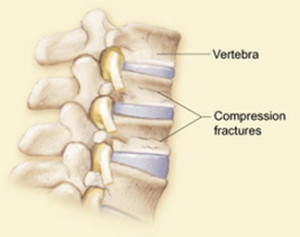Is Your Back Pain a Spine Compression Fracture?
A compression fracture is the type of fracture in the spine that is usually caused by osteoporosis. Compression fractures are also referred to as vertebral fractures, osteoporotic fractures, or wedge fractures.
To be classified as a compression fracture, the vertebral bone in the spine will have decreased at least 15 to 20 percent in height due to fracture. These fractures can occur in vertebrae anywhere in the spine, but they tend to occur most often in the thoracic spine, or upper back, especially in the lower vertebrae of that section.
3 Types of Fractures
1. Wedge fractures usually occur in the front of the vertebra and collapse the bone in the front of the spine and leave the back of the same bone unchanged, resulting in a wedge-shaped vertebra. Wedge compression fractures are usually a mechanically stable fracture pattern.
2. Crush fractures refer to fractures in which the entire bone breaks, rather than just the front of the vertebra.
3. Burst fractures involve some loss of the height in both the front and back walls of the vertebral body, which is significant because burst fractures can be unstable and result in progressive deformity or neurological problems.
Spinal Compression Fracture Symptoms
Spinal fractures usually result in acute back pain, which may lead to chronic pain, deformity, loss of height, crowding of internal organs, and loss of muscle and aerobic conditioning due to lack of activity and exercise. The majority of damage is limited to the front of the vertebral column, so the fracture is usually stable and is rarely associated with any nerve or spinal cord damage.
Spinal compression fractures occur in approximately 700,000 people in the U.S. each year, making them a rather common back problem. If you suspect you have a compression fracture, make an appointment to see Dr. Sharma today.

Categories
Archives
Contact Dr. Mudit Sharma
Phone: (571) 921-4877
Toll Free: (855) 774-6334
Monday – Thursday: 8am – 4pm
Friday: 8am – 2pm
Fredericksburg
4604 Spotsylvania Parkway, Suite 300 Fredericksburg, VA 22408
Manassas
8650 Sudley Road, Suite 315
Manassas, VA 20110-4418

